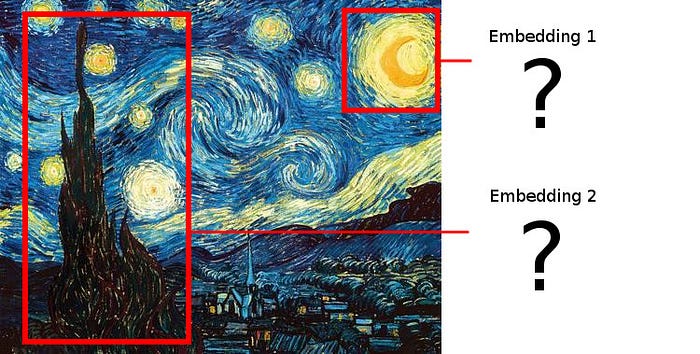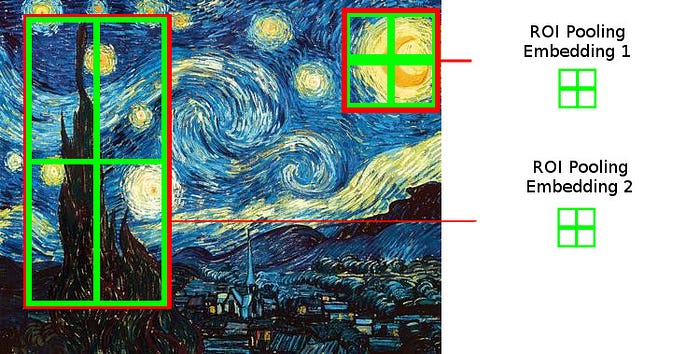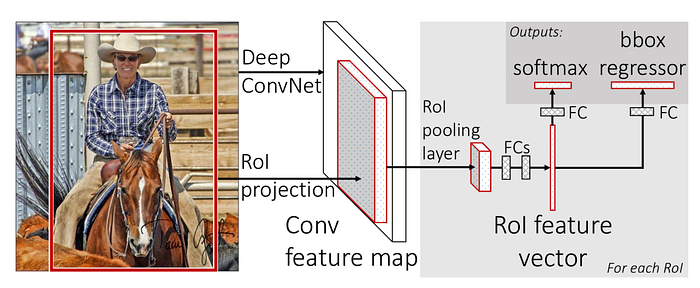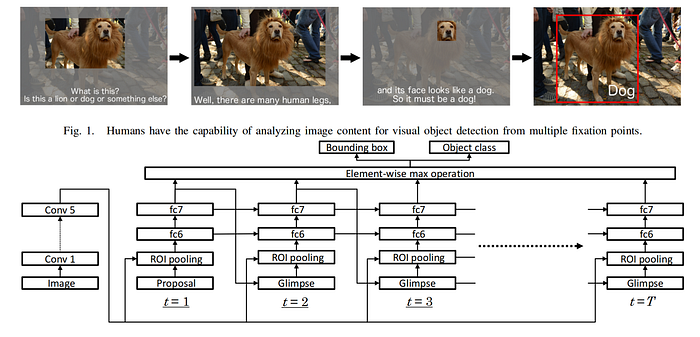مرحبا يا هبر! أقدم انتباهكم إلى ترجمة المقال "تنفيذ تجمع العائد على الاستثمار في TensorFlow + Keras" بقلم خايمي إشبيلية.
أتلقى حاليًا دورة تعلُّم الآلة. في كتلة التدريب "رؤية الكمبيوتر" ، كانت هناك حاجة لدراسة تجميع طبقات ROI. بدت المقالة أدناه مثيرة للاهتمام بالنسبة لي ، لذلك قررت مشاركة الترجمة مع المجتمع.
في هذا المنشور ، سنشرح المفهوم الأساسي والاستخدام العام لتجميع العائد على الاستثمار ( منطقة الاهتمام ) ونوفر تنفيذًا باستخدام طبقات TensorFlow Keras.
الجمهور المستهدف من هذا المنشور هو الأشخاص الذين هم على دراية بالنظرية الأساسية للشبكات العصبية (التلافيفية) (CNNs) وقادرين على بناء وتشغيل نماذج بسيطة باستخدام Keras .
إذا كنت هنا فقط للحصول على التعليمات البرمجية ، فابحث هنا ولا تنسى الإعجاب ومشاركة المقالة!
فهم تجمع عائد الاستثمار
تم اقتراح RoI Pooling بواسطة Ross Girshik في مقالة Fast R-CNN كجزء من خط أنابيب التعرف على الكائنات.
في حالة الاستخدام العام لـ RoI Pooling ، لدينا كائن يشبه الصورة والعديد من مناطق الاهتمام ( RoI ) ، المشار إليها من خلال المربعات المحيطة. نريد إنشاء التضمينات (التضمين - تعيين كيان تعسفي (قطعة من الصورة) إلى ناقل معين) من كل عائد استثمار.
على سبيل المثال ، في إعداد R-CNN ، لدينا صورة ومحرك يسلط الضوء على المنطقة المرشحة التي تنشئ مربعات محيط لأجزاء محتملة مثيرة للاهتمام من الصورة. نريد الآن إنشاء تضمين لكل قطعة مقترحة من الصورة.

لن يعمل اقتصاص كل منطقة مقترحة ببساطة لأننا نريد تراكب التضمينات الناتجة فوق بعضها البعض ، وليس بالضرورة أن يكون للمناطق المقترحة نفس الشكل!
, . ?
- (pooling).
max pooling, ( ) , , .

maxpool
, – : .
. RoI ?

ROI Pooling , pooling.
, ROI Pooling.
RoI Pooling.
RoI Pooling — . , RoI, . , .
-, ( RoI Pooling ), ( ), (end-to-end) (single-pass) .

Fast R-CNN, RoI Pooling,
, R-CNN , (RoI). RoI Pooling CNN . .
-, -, RoI Pooling (visual attention).

Attentional Network , ROI Pooling, Hara ..
Attentional Network , Hara attention, ROI ROI Pooling. (t = 1), ROI Pooling (Fully Connected). Glimpse () (t = 2) , ROI Pooling. .
.
, , ROI.
:
- (batch) . , . (batch_size, img_width, img_height, n_channels), batch_size- , img_width — , img_height — , n_channels — .
- (batch) ROI. , - . 4 , (batch_size, n_rois, 4), batch_size — ROI, n_rois — ROI.
:
- , ROI. (batch_size, n_rois, pooled_width, pooled_height, n_channels). batch_size- , n_rois — ROI, pooled_width — , pooled_height— , n_channels — .
Keras
Keras Layer.
tf.keras init, build call . , build , , . compute_output_shape.
, .
def __init__(self, pooled_height, pooled_width, **kwargs):
self.pooled_height = pooled_height
self.pooled_width = pooled_width
super(ROIPoolingLayer, self).__init__(**kwargs). , . .
def compute_output_shape(self, input_shape):
""" Returns the shape of the ROI Layer output
"""
feature_map_shape, rois_shape = input_shape
assert feature_map_shape[0] == rois_shape[0]
batch_size = feature_map_shape[0]
n_rois = rois_shape[1]
n_channels = feature_map_shape[3]
return (batch_size, n_rois, self.pooled_height,
self.pooled_width, n_channels)compute_output_shape — , , .
(call). — , . , ROI Pooling, .
, , ROI .
.
@staticmethod
def _pool_roi(feature_map, roi, pooled_height, pooled_width):
""" Applies ROI Pooling to a single image and a single ROI
"""# Compute the region of interest
feature_map_height = int(feature_map.shape[0])
feature_map_width = int(feature_map.shape[1])
h_start = tf.cast(feature_map_height * roi[0], 'int32')
w_start = tf.cast(feature_map_width * roi[1], 'int32')
h_end = tf.cast(feature_map_height * roi[2], 'int32')
w_end = tf.cast(feature_map_width * roi[3], 'int32')
region = feature_map[h_start:h_end, w_start:w_end, :]
..., .
, ROI , 0 1. , ROI 4- , (x_min, y_min, x_max, y_max ).
ROI , , , : , , ROI Pooling, , , ROI.
, TensorFlow.
...
# Divide the region into non overlapping areas
region_height = h_end - h_start
region_width = w_end - w_start
h_step = tf.cast(region_height / pooled_height, 'int32')
w_step = tf.cast(region_width / pooled_width , 'int32')
areas = [[(
i*h_step,
j*w_step,
(i+1)*h_step if i+1 < pooled_height else region_height,
(j+1)*w_step if j+1 < pooled_width else region_width
)
for j in range(pooled_width)]
for i in range(pooled_height)]
...ROI, .
2D , , , .
, , , , ROI (region_height // pooled_height, region_width // pooled_width), ROI, .
2D , .
...
# Take the maximum of each area and stack the result
def pool_area(x):
return tf.math.reduce_max(region[x[0]:x[2],x[1]:x[3],:], axis=[0,1])
pooled_features = tf.stack([[pool_area(x) for x in row] for row in areas])
return pooled_features . pool_area, , , , , .
pool_area , , list comprehension .
(pooled_height, pooled_width, n_channels), RoI .
— RoI . tf.map_fn (n_rois, pooled_height, pooled_width, n_channels).
@staticmethod
def _pool_rois(feature_map, rois, pooled_height, pooled_width):
""" Applies ROI pooling for a single image and varios ROIs
"""
def curried_pool_roi(roi):
return ROIPoolingLayer._pool_roi(feature_map, roi,
pooled_height, pooled_width)
pooled_areas = tf.map_fn(curried_pool_roi, rois, dtype=tf.float32)
return pooled_areas, . tf.map_fn (, x), , .
def call(self, x):
""" Maps the input tensor of the ROI layer to its output
"""
def curried_pool_rois(x):
return ROIPoolingLayer._pool_rois(x[0], x[1],
self.pooled_height,
self.pooled_width)
pooled_areas = tf.map_fn(curried_pool_rois, x, dtype=tf.float32)
return pooled_areas, dtype tf.map_fn , . , , , Tensorflow.
:
import tensorflow as tf
from tensorflow.keras.layers import Layer
class ROIPoolingLayer(Layer):
""" Implements Region Of Interest Max Pooling
for channel-first images and relative bounding box coordinates
# Constructor parameters
pooled_height, pooled_width (int) --
specify height and width of layer outputs
Shape of inputs
[(batch_size, pooled_height, pooled_width, n_channels),
(batch_size, num_rois, 4)]
Shape of output
(batch_size, num_rois, pooled_height, pooled_width, n_channels)
"""
def __init__(self, pooled_height, pooled_width, **kwargs):
self.pooled_height = pooled_height
self.pooled_width = pooled_width
super(ROIPoolingLayer, self).__init__(**kwargs)
def compute_output_shape(self, input_shape):
""" Returns the shape of the ROI Layer output
"""
feature_map_shape, rois_shape = input_shape
assert feature_map_shape[0] == rois_shape[0]
batch_size = feature_map_shape[0]
n_rois = rois_shape[1]
n_channels = feature_map_shape[3]
return (batch_size, n_rois, self.pooled_height,
self.pooled_width, n_channels)
def call(self, x):
""" Maps the input tensor of the ROI layer to its output
# Parameters
x[0] -- Convolutional feature map tensor,
shape (batch_size, pooled_height, pooled_width, n_channels)
x[1] -- Tensor of region of interests from candidate bounding boxes,
shape (batch_size, num_rois, 4)
Each region of interest is defined by four relative
coordinates (x_min, y_min, x_max, y_max) between 0 and 1
# Output
pooled_areas -- Tensor with the pooled region of interest, shape
(batch_size, num_rois, pooled_height, pooled_width, n_channels)
"""
def curried_pool_rois(x):
return ROIPoolingLayer._pool_rois(x[0], x[1],
self.pooled_height,
self.pooled_width)
pooled_areas = tf.map_fn(curried_pool_rois, x, dtype=tf.float32)
return pooled_areas
@staticmethod
def _pool_rois(feature_map, rois, pooled_height, pooled_width):
""" Applies ROI pooling for a single image and varios ROIs
"""
def curried_pool_roi(roi):
return ROIPoolingLayer._pool_roi(feature_map, roi,
pooled_height, pooled_width)
pooled_areas = tf.map_fn(curried_pool_roi, rois, dtype=tf.float32)
return pooled_areas
@staticmethod
def _pool_roi(feature_map, roi, pooled_height, pooled_width):
""" Applies ROI pooling to a single image and a single region of interest
"""
# Compute the region of interest
feature_map_height = int(feature_map.shape[0])
feature_map_width = int(feature_map.shape[1])
h_start = tf.cast(feature_map_height * roi[0], 'int32')
w_start = tf.cast(feature_map_width * roi[1], 'int32')
h_end = tf.cast(feature_map_height * roi[2], 'int32')
w_end = tf.cast(feature_map_width * roi[3], 'int32')
region = feature_map[h_start:h_end, w_start:w_end, :]
# Divide the region into non overlapping areas
region_height = h_end - h_start
region_width = w_end - w_start
h_step = tf.cast( region_height / pooled_height, 'int32')
w_step = tf.cast( region_width / pooled_width , 'int32')
areas = [[(
i*h_step,
j*w_step,
(i+1)*h_step if i+1 < pooled_height else region_height,
(j+1)*w_step if j+1 < pooled_width else region_width
)
for j in range(pooled_width)]
for i in range(pooled_height)]
# take the maximum of each area and stack the result
def pool_area(x):
return tf.math.reduce_max(region[x[0]:x[2], x[1]:x[3], :], axis=[0,1])
pooled_features = tf.stack([[pool_area(x) for x in row] for row in areas])
return pooled_features! , 1- 100x200, 2 RoI, 7x3. , 4 . — 1, 50 (-1, -3).
import numpy as np# Define parameters
batch_size = 1
img_height = 200
img_width = 100
n_channels = 1
n_rois = 2
pooled_height = 3
pooled_width = 7# Create feature map input
feature_maps_shape = (batch_size, img_height, img_width, n_channels)
feature_maps_tf = tf.placeholder(tf.float32, shape=feature_maps_shape)
feature_maps_np = np.ones(feature_maps_tf.shape, dtype='float32')
feature_maps_np[0, img_height-1, img_width-3, 0] = 50
print(f"feature_maps_np.shape = {feature_maps_np.shape}")# Create batch size
roiss_tf = tf.placeholder(tf.float32, shape=(batch_size, n_rois, 4))
roiss_np = np.asarray([[[0.5,0.2,0.7,0.4], [0.0,0.0,1.0,1.0]]], dtype='float32')
print(f"roiss_np.shape = {roiss_np.shape}")# Create layer
roi_layer = ROIPoolingLayer(pooled_height, pooled_width)
pooled_features = roi_layer([feature_maps_tf, roiss_tf])
print(f"output shape of layer call = {pooled_features.shape}")# Run tensorflow session
with tf.Session() as session:
result = session.run(pooled_features,
feed_dict={feature_maps_tf:feature_maps_np,
roiss_tf:roiss_np})
print(f"result.shape = {result.shape}")
print(f"first roi embedding=\n{result[0,0,:,:,0]}")
print(f"second roi embedding=\n{result[0,1,:,:,0]}"), TensorFlow, .
:
feature_maps_np.shape = (1, 200, 100, 1)
roiss_np.shape = (1, 2, 4)
output shape of layer call = (1, 2, 3, 7, 1)
result.shape = (1, 2, 3, 7, 1)
first roi embedding=
[[1. 1. 1. 1. 1. 1. 1.]
[1. 1. 1. 1. 1. 1. 1.]
[1. 1. 1. 1. 1. 1. 1.]]
second roi embedding=
[[ 1. 1. 1. 1. 1. 1. 1.]
[ 1. 1. 1. 1. 1. 1. 1.]
[ 1. 1. 1. 1. 1. 1. 50.]], . — 1, , 50.
, !
, !
, ROI Pooling (attention). , , Keras , ROI Pooling .
, , , !
Ari Brill, Tjark Miener Bryan Kim .
- Ross Girshick. Fast R-CNN. Proceedings of the IEEE International Conference on Computer Vision. 2015.
- Kota Hara, Ming-Yu Liu, Oncel Tuzel, Amir-massoud Farahmand. Attentional Network for Visual Object Detection. 2017.